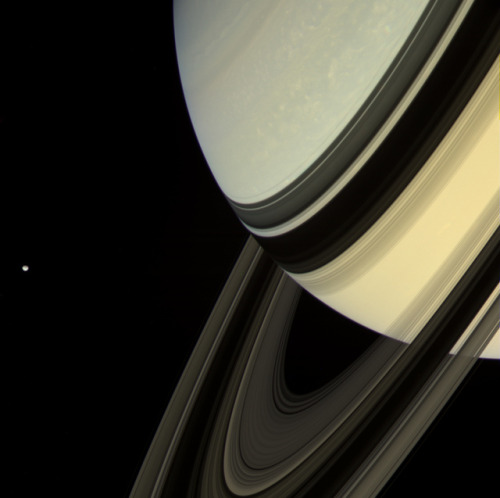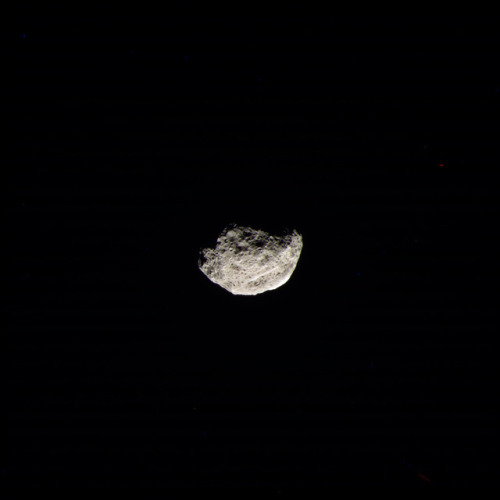Picture Of The Day - November 20, 2018

Picture of the day - November 20, 2018
Dark red nebula rises over a dim set of rings orbiting a gas giant.
More Posts from Sharkspaceengine and Others

Incredible “EPIC” View Of The Moon Passing In Front Of The Earth
This is real, folks. It is not a computer-generated animation. NASA’s DSCOVR (Deep Space Climate Observatory) satellite took these incredible shots on July 16 using its Earth-facing EPIC camera from its vantage point between the Earth and the Sun, a million miles away!
DSCOVR sits at what’s known as the L1 Lagrangian point, where the gravitational pull of the Earth and Sun balance out in such a way that satellites positioned there can remain in stable orbit while using minimal energy:

Image: NASA/NOAA
This view of the far side of the Moon reminds us that it is anything but dark. The Moon is tidally locked, meaning that we see the same face all the time, but the sun regularly shines on the side that we don’t see (we’re just seeing a new or crescent moon when that happens). The far side also lacks the dark plains, or maria, that texture the Earth-facing side, made of basalt laid down by ancient lunar lava flows, reminding us that our lunar satellite has a complex geologic history:

Picture of the day - February 14, 2019 (Late Post).
A dark nebula obscures the galaxy.







Oculus System - Post 3 (Cratered Wasteland)
The system’s third planet is a nearly airless Mars-sized world, heavily cratered world. The planet orbits 1.19 AU from the sun, has a mass of just 8.6% that of Earth and roughly half of Earth’s diameter. A tenuous carbon dioxide atmosphere clings to the surface with a surface press of just 1/100,000th that of Earth. Surface temperatures can reach the boiling point of water during the day, and fall nearly -300 °F at night.
High Resolution Pics
Picture 1 - Mercury-like planet
Picture 2 - Two small satellites
Picture 3 - A view from a moon
Picture 4 - Setting Sun.
Picture 5 - Broken Crater
Picture 6 - From just 10 km above the surface.
Picture 7 - The Surface
Insight A System (Outer 4 Planets)
Here are the outer 4 planets orbiting Insight A. Each planet has a large ring systems.
Insight A-VI (0.65 Earth masses, Water World with life, 1.10 AU)

Insight A-VII (3.10 Earth masses, Cold Desert World, 1.97 AU)

Insight A-VIII (15.46 Earth Masses, Ice Giant, 4.01 AU)

Insight A-IX (17.40 Earth Masses, Ice Giant, 7.34 AU)

Space Engine System ID: RS-5581-42-6-76887-1116 A





Pictures of the Day 2 - December 30, 2018
Here we come across an Earth-like world with violet hued skies. This planet supports marine life and orbits a star within a globular cluster. There are 137 star systems just within 5 light years of this planet, and the planet’s sky is lit up with their light. Most of the stars are close enough to be visible during the day. Additionally, this planet is located within a quandary star system consisting of an K type orange dwarf orbited three smaller red dwarfs in a wide complex orbit.
While Earth-Like, there are notable differences from Earth. First, the planet has almost no obliquity meaning it has no axial tilt and therefore does not experience seasons. Massive ice caps cover both poles. The planet also spins very slowly with a solar day lasting almost 3.86 Earth days. Only 4 small asteroid moons orbit the planet. Additionally, life is limited to the oceans, and the atmosphere is almost entirely made up of carbon dioxide.
Space Engine System ID: RSC 5581-4-4-2706-51 A4 to visit the system in Space Engine.
Planet Stats Below:
Radius: 5,268.61 km (0.83 x Earth) Mass: 0.59 Earth Masses Orbital Distance: 0.43 AU Length of Year: 118.88 Days Length of Solar Day: 3.86 Days Gravity: 0.86 g Average Temperature: 277 K (39° F) Atmospheric Pressure: 0.52 Atmospheres Atmospheric Composition: 92.7% Carbon Dioxide, 4.23% Nitrogen, 3.02% Oxygen, 0.05% Sulfur Dioxide.
Thank You for Following
I see I now have 13 followers. Thank you for that. Glad to see other people are enjoying my space engine pics and other astronomy topics.
Once again thank you.

Picture of the Day - January 13, 2019
Aurora’s dance over the northern pole and a hazy world.
Vibrant Rings

Picture of the Day - November 1, 2018
I’ve decided to move closer to home and am now exploring the Large Magellanic Cloud Galaxy. You’ll see in numerous pictures the Milky Way in the background covering almost a quarter of the sky in some locations
First picture from the new galaxy a ringed ice-giant with a colorful ring system.










Saturn, rings and moons
NASA/JPL-Caltech/SSI/Kevin M. Gill
-
 jmlkhan21-blog liked this · 6 years ago
jmlkhan21-blog liked this · 6 years ago -
 sharkspaceengine reblogged this · 6 years ago
sharkspaceengine reblogged this · 6 years ago
My Space Engine Adventures, also any space related topic or news. www.spaceengine.org to download space engine. The game is free by the way. Please feel free to ask me anything, provide suggestions on systems to visit or post any space related topic.Check out my other blog https://bunsandsharks.tumblr.com for rabbit and shark blog.
294 posts
